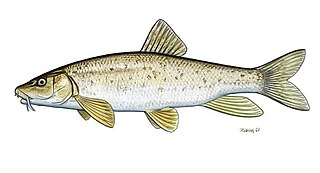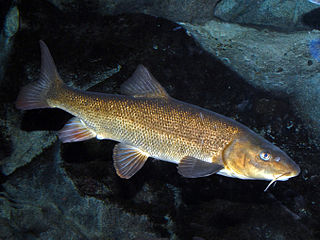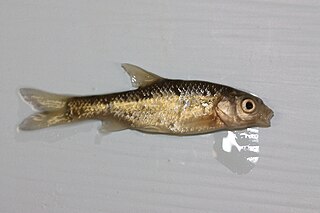
Barbus is a genus of ray-finned fish in the family Cyprinidae. The type species of Barbus is the common barbel, first described as Cyprinus barbus and now named Barbus barbus. Barbus is the namesake genus of the subfamily Barbinae, but given their relationships, that taxon is better included in the Cyprininae at least for the largest part.
The Albanian barbel is a ray-finned fish species in the family Cyprinidae. It is often referred to as "Albanian barbel" in a literal translation of its scientific name.

The brook barbel is a species of ray-finned fish in the family Cyprinidae. It is found in Italy and Switzerland. Its natural habitat is rivers. It is threatened by habitat degradation and by competition from the introduced B. barbus and Luciobarbus graellsii.
Barbus cyclolepis, the round-scaled barbel, is a freshwater fish species in the family Cyprinidae. It is found in Bulgaria, Greece, and Turkey. Its natural habitats are rivers and intermittent rivers. It is not considered a threatened species by the IUCN.
The Evia barbel or petropsaro, is a species of freshwater fish in the family Cyprinidae found only in Greece. It is endemic to the Euboea Island and they're now restricted to a single stream, Manikiotikos, in the southern part of the island. During the dry season it may be found just in a few intermittent pools. It is threatened by habitat loss and considered Endangered.
Luciobarbus graecus is a ray-finned fish species in the family Cyprinidae. It is here placed in Luciobarbus following the IUCN, but that genus is very closely related to the other typical barbels and perhaps better considered a mere subgenus of Barbus. Found in and adjacent to Greece, its closest living relative seems to be L. lydianus, which is found in the northwest of Asia Minor.

Labeobarbus intermedius is an East African ray-finned fish species in the family Cyprinidae. Like the closely related yellowfish, it is hexaploid. A large species, the maximum recorded standard length is nearly 50 cm (20 in). This species has a subspecies named Labeobarbus intermedius intermedius.

The Mediterranean barbel or southern barbel is a species of ray-finned fish in the family Cyprinidae. It is found in France and Spain. It is one of the tastiest river fish, prized for its delicate texture and succulent flavor.

Barbus peloponnesius is a ray-finned fish species in the family Cyprinidae. The western Balkan barbel is sometimes included in the present species.

The Italian barbel is a species of freshwater fish in the family Cyprinidae, nearly related to the common barbel Barbus barbus. The name barbel derived from the Latin barba, meaning beard, a reference to the two pairs of barbels, a longer pair pointing forwards and slightly down positioned, on the side of the mouth.
The Briána is a species of cyprinid fish.

The giant Atlas barbel was a ray-finned fish species in the family Cyprinidae. It was the only species in the genus Atlantor but it is now thought to be extinct.
Synodontis rebeli is a species of upside-down catfish endemic to Cameroon where it occurs in the Sanaga River basin. This species grows to a length of 26.2 centimetres (10.3 in) TL.
Luciobarbus is a genus of ray-finned fishes in the family Cyprinidae. Its members are found in fresh and brackish waters of southern Europe, northern Africa, the wider Near East, the Aral and Caspian Seas, and rivers associated with these. Several species in the genus are threatened. Most species are fairly small to medium-sized cyprinids, but the genus also includes several members that can surpass 1 m (3.3 ft) in length and the largest, the mangar can reach 2.3 m (7.5 ft).

The Romanian barbel is a species of ray-finned fish in the genus Barbus. It occurs in the lower Danube basin of Bulgaria and Romania, as well as in several rivers of Bulgaria flowing into the Black Sea, such as Kamchiya. The species is named after János Salamon Petényi.

Barbus sperchiensis is a disputed species of cyprinid fish in the genus Barbus. It is a freshwater fish endemic to the Spercheios river complex, Central Greece.

The horse barbel is a species of ray-finned fish in the genus Barbus which is endemic to Italy.

The chubbyhead barb is a species of freshwater ray-finned fish in the genus Enteromius. The fish is found throughout South Africa in a variety of aquatic environments. The species is notable for its two breeding seasons, which allows it to flourish despite a short lifespan.
The lizard barbel, also known as Kura barbel, is a species of freshwater cyprinid fish from the Near East region. Kosswig's barbel is now a synonym, which also places the species in the Tigris–Euphrates river system of the Middle east.

The Crimean barbel is a species of ray-finned fish in the genus Barbus.












